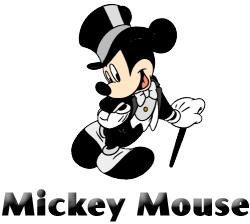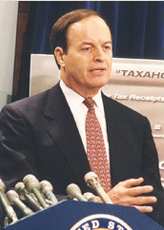How Disney Got Two No-Fly Zones Without Public Debate
 So that's how it happened. Pilots certainly didn't
want them. The Department of Homeland Security didn't ask for them.
Neither did the TSA. In fact, Congress had to bend its own rules to
accommodate the request. All because a high-powered lobbyist for
the Disney organization asked lawmakers to establish no-fly zones
over its theme parks in Florida and California. That means no
aerial tours of the Magic Kingdom and no banner-tows above the
park.
So that's how it happened. Pilots certainly didn't
want them. The Department of Homeland Security didn't ask for them.
Neither did the TSA. In fact, Congress had to bend its own rules to
accommodate the request. All because a high-powered lobbyist for
the Disney organization asked lawmakers to establish no-fly zones
over its theme parks in Florida and California. That means no
aerial tours of the Magic Kingdom and no banner-tows above the
park.
Was It Safety Concerns... Or Something Else?
"Disney tried to make that restricted airspace for years but
couldn't until now because the airspace belongs to the people, not
to a corporation," said Joe Kittinger, a retired Air Force colonel
and longtime Orlando aerial advertiser, in an interview with
The Orlando Sentinel. "They've achieved it now under the
guise of national security, and there is absolutely no reason for
it."

Disney executives say they did absolutely nothing wrong in going
straight to Capitol Hill and getting lawmakers to order the FAA to
set up the air exclusion zones. They may have pitched it to
Congress as a security-only issue, but one Disney spokeswoman
admitted terror fears weren't necessarily at the top of Disney's
reasons for going to Washington.
"The sole and exclusive motivation for seeking these
restrictions is for the safety and enjoyment of our guests," Disney
spokeswoman Leslie Goodman told The Sentinel, saying
"enjoyment" meant everything from keeping out "banner ads from
trial lawyers" to pilots "buzzing the parks."
"Disney park officials have wanted to eliminate air traffic over
the parks long before 9-11," AOPA President Phil Boyer was quoted
as saying to The Sentinel. His group wants the FAA to
eliminate Disney's no-fly zones. "Did they employ lobbyists to
convince FAA to finally 'ban' general aviation in the guise of
security?"

What Is Disney Afraid Of?
 John Pike, director of GlobalSecurity.org, a
defense think tank in Alexandria (VA), was quoted in The
Sentinel as saying, "Apart from warning away law-abiding
pilots, it's not clear to me what this is going to buy you."
Indeed, he says, the 3-mile, 3000 foot exclusion zones provide
little protection and are just too hard to enforce - especially
given the fact that both Disney parks are close to busy
airports.
John Pike, director of GlobalSecurity.org, a
defense think tank in Alexandria (VA), was quoted in The
Sentinel as saying, "Apart from warning away law-abiding
pilots, it's not clear to me what this is going to buy you."
Indeed, he says, the 3-mile, 3000 foot exclusion zones provide
little protection and are just too hard to enforce - especially
given the fact that both Disney parks are close to busy
airports.
"It's not clear to me what difference this would make unless
they're going to put some antiaircraft missiles in front of
(Cinderella) Castle or something to enforce it."
(Can you picture some PR type at Disney thinking right now,
"missiles... yeah, that'll attract an even bigger crowd...")
So How Did This Happen?
 The Sentinel reports the air-exclusion
zones were instituted based on a mere 65 words - most of them
beyond the average lawmaker's ability to recognize technical jargon
- in a 3000 page, $397.4 million spending bill. Not once, reports
the newspaper, was the word "Disney" printed in the bill. When
Senate negotiators to meet privately for talks aimed at reconciling
their differences over the spending bill, Sen. Ted Stevens (R-AK)
and Sen. Richard Shelby (R-AL) were reportedly the driving forces
behind the no-fly zones.
The Sentinel reports the air-exclusion
zones were instituted based on a mere 65 words - most of them
beyond the average lawmaker's ability to recognize technical jargon
- in a 3000 page, $397.4 million spending bill. Not once, reports
the newspaper, was the word "Disney" printed in the bill. When
Senate negotiators to meet privately for talks aimed at reconciling
their differences over the spending bill, Sen. Ted Stevens (R-AK)
and Sen. Richard Shelby (R-AL) were reportedly the driving forces
behind the no-fly zones.
"Mr. Shelby and Mr. Stevens had some particular interest in
adding Disney," said a House source familiar with the meetings, in
an interview with the newspaper. The Sentinel quotes
another Capitol Hill source as saying Shelby and Stevens were
heavily influenced by a former employee of that Alaska Senator -
Mitch Rose - who's worked as a Disney lobbyist since 2000.
 So why not make the permanent bans effective over
other major entertainment venues, such as Six Flags amusement parks
or NASCAR motor speedways? Sen. Shelby specifically rejected the
idea.
So why not make the permanent bans effective over
other major entertainment venues, such as Six Flags amusement parks
or NASCAR motor speedways? Sen. Shelby specifically rejected the
idea.
"Along with the protections for certain sporting events (some
professional baseball and football games), it is the intent of . .
. (Congress) to provide protection from certain overflights only
for Walt Disney World in Orlando, Florida and Disneyland in
Anaheim, California," Shelby wrote in the letter, obtained by
The Orlando Sentinel.
Who's Next?
Remember Chicago Mayor Richard Daley, the man who bulldozed
Meigs Field in the middle of the night? He's reportedly
red-in-the-face angry that Disney was granted the no-fly zones and
Chicago wasn't.
"Now, think of that: Mickey and Minnie have it. I mean, I can't
believe that. They get it first before we get it," Daley told
The Chicago Tribune on March 19. Eventually, Illinois
lawmakers were able to get a no-fly zone instituted over Chicago.
The FAA, however, took it down when the national terror threat
assessment was most recently lowered.
 NTSB Prelim: Lee Aviation LLC JA30 SuperStol
NTSB Prelim: Lee Aviation LLC JA30 SuperStol Classic Aero-TV: Curtiss Jenny Build Wows AirVenture Crowds
Classic Aero-TV: Curtiss Jenny Build Wows AirVenture Crowds ANN's Daily Aero-Term (05.30.25): Very High Frequency (VHF)
ANN's Daily Aero-Term (05.30.25): Very High Frequency (VHF) Aero-News: Quote of the Day (05.30.25)
Aero-News: Quote of the Day (05.30.25) Classic Aero-TV: Quest Kodiak Enhances Migration Monitoring Programs
Classic Aero-TV: Quest Kodiak Enhances Migration Monitoring Programs








